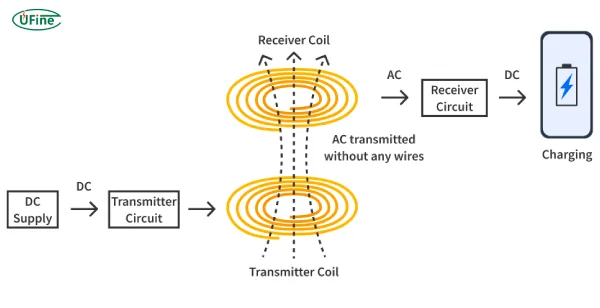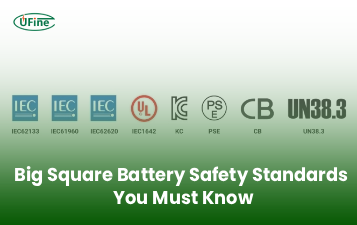
- Part 1. How wireless charging works
- Part 2. Lithium-ion battery basics: what damages a battery?
- Part 3. Heat and wireless charging
- Part 4. Fast wireless charging: convenience vs. longevity
- Part 5. What smartphone makers say (Apple, Samsung, Google, Huawei)
- Part 6. Wireless charging in real-world scenarios
- Part 7. How to wireless charge without damaging your battery
- Part 8. Wired vs. wireless charging: Full technical comparison
- Part 9. Final verdict
Wireless charging has become increasingly popular in recent years, offering a convenient way to power up smartphones, earbuds, and other devices without plugging in cables. Major brands like Apple, Samsung, and Google have adopted Qi wireless charging as a standard feature in their flagship devices.
Part 1. How wireless charging works
Wireless charging uses electromagnetic induction to transfer energy from a power source (the charging pad) to your device without physical connectors. Here’s a breakdown:
Key Components:
- Transmitter (Charging Pad) – Generates an alternating electromagnetic field.
- Receiver (Inside Your Device) – Converts the electromagnetic energy back into electricity to charge the battery.

Types of Wireless Charging:
- Qi Standard (Inductive Charging) – Most common (used by iPhones, Samsung Galaxy, etc.).
- Resonant Wireless Charging – Allows for slightly greater distance but less efficient.
- RF Wireless Charging (Experimental) – Still in development, promises true “over-the-air” charging.
Since Qi charging is the most widely used, we’ll focus on its effects on battery health.
Pros of wireless charging:
- Eliminates wear and tear on charging ports
- Supports waterproof design (no open ports)
- Offers elegant, cable-free setups
Cons:
- Less energy efficient (typically 70–85% vs. 95% for wired)
- Generates more heat during charging
- Slower than fast-wired charging in most cases
Part 2. Lithium-ion battery basics: what damages a battery?
Most smartphones use lithium-ion (Li-ion) batteries, prized for high energy density and rechargeability. However, they degrade over time due to chemical wear. Key stressors include:
- High temperature: Above 35°C (95°F) accelerates degradation
- Staying at 100% for long periods: Promotes lithium plating on the anode
- Frequent full discharges (0-10%): Strains battery chemistry
- Excessive charging current: Fast charging generates internal resistance
Battery degradation leads to:
- Loss of capacity (holding less charge)
- Increased charging time
- More frequent recharges
- Potential for swelling or failure
Guide to Understand Lithium Battery Overheating
Understanding these wear mechanisms is critical to evaluating how wireless charging might accelerate or mitigate these effects.
Part 3. Heat and wireless charging

Wireless charging is less efficient than wired methods, and the excess energy is dissipated as heat.
What the data shows:
- Typical wireless charging raises battery temperature by 5°C to 10°C more than wired.
- Fast wireless charging (15W and above) can reach battery temps exceeding 40°C.
- Poor alignment or use of cases can increase this inefficiency and thermal output.
Why this matters:
- Heat is the number one enemy of lithium-ion batteries.
- A study by Battery University shows that at 40°C, battery lifespan may be halved compared to charging at 25°C.
Mitigation techniques:
- Use pads with built-in temperature regulation
- Avoid charging on soft surfaces (like beds) that trap heat
- Remove heavy cases before charging
Part 4. Fast wireless charging: convenience vs. longevity
With fast wireless charging now exceeding 30W on some phones, thermal stress becomes a more serious concern.
Fast vs. Standard Wireless Charging:
- Standard (5–10W): Slower, gentler on batteries
- Fast (15–50W): Shortens charge time but increases heat
Testing insight:
- In controlled lab tests, fast wireless charging raised device temps by 12–15°C over ambient temperature
- Brands like Xiaomi and Oppo have built fans or cooling vents into pads to compensate
Recommendation:
- Use fast wireless charging sparingly (e.g., emergency top-ups)
- Prefer standard speeds for overnight or habitual charging
Is Fast Charging a Battery Harmful to Lithium Batteries?
Part 5. What smartphone makers say (Apple, Samsung, Google, Huawei)
Smartphone brands now build in Battery Management Systems (BMS) to mitigate risk:
- Apple: Optimized Battery Charging slows down the charge after 80%
- Samsung: Offers a battery protection mode that caps charge at 85%
- Google Pixel: Adapts charging speed based on user behavior
- Huawei: Uses AI-based charging pattern analysis
Manufacturer Position:
- All major OEMs state that certified Qi wireless charging is safe for daily use
- They caution against non-certified third-party pads which may not throttle heat or current correctly
Part 6. Wireless charging in real-world scenarios
To evaluate the practical impact, let’s examine some common usage cases:
A. Overnight Charging
- Constant exposure to high SoC (90–100%) is more harmful than the charging method itself.
- If a wireless pad doesn’t regulate charging, trickle top-ups can generate heat repeatedly.
B. Using Phone While Charging
- Causes heat buildup from both internal and external sources
- Worse with wireless charging due to less cooling efficiency
C. Charging Through Thick Cases
- Misalignment and insulation lead to inefficient charging and more heat
- Can cause the charger to work harder, generating more thermal stress
- Conclusion: Real-world behavior (heat, case use, phone usage) often has more influence on battery health than the charging method itself.
Part 7. How to wireless charge without damaging your battery
To enjoy wireless charging without harming battery life:
1.Use Certified Pads
- Look for Qi certification
- Avoid ultra-budget brands without thermal safety
2. Keep It Cool
- Charge in ventilated areas
- Remove thick or metal-backed phone cases
3. Don’t Always Charge to 100%
- Stop at 80–90% to reduce cycle wear
- Use built-in battery protection settings where available
4. Avoid Phone Use While Charging
- Heavy use adds internal heat
- Let the phone rest for optimal battery health
5. Monitor Battery Temps
- Use apps like AccuBattery or Battery Guru
- If the phone gets too hot, pause charging
6. Rotate Charging Methods
- Mix wired and wireless to avoid repeated thermal cycles
Part 8. Wired vs. wireless charging: Full technical comparison
| Criteria | Wired Charging | Wireless Charging |
|---|---|---|
| Speed | Fastest (especially >30W) | Generally slower (unless fast pads used) |
| Heat | Lower (more efficient) | Higher due to energy loss |
| Port Wear | High (plug/unplug damage) | None |
| Convenience | Medium | High |
| Safety Risk | Low | Higher if pad quality is poor |
| Long-Term Battery Impact | Moderate | Higher if poorly managed |
Expert Verdict: Wired charging is technically safer for battery life, but wireless is safe enough when used correctly.
Part 9. Final verdict
In practical terms: No — wireless charging does not inherently damage your battery.
However, risks arise from excess heat, poor-quality chargers, and bad charging habits. When used correctly — with certified chargers, proper ventilation, and occasional usage — wireless charging is a safe, convenient alternative.
Bottom Line:
- Occasional wireless charging: Safe
- Daily wireless charging with quality pads: Still safe
- Fast wireless charging in hot environments: Caution advised
By understanding how wireless charging works and adjusting your behavior, you can enjoy the convenience without compromising your battery’s lifespan.
Related Tags:
More Articles

Big Square Battery Safety Standards You Must Know
Learn key safety standards for big square batteries to avoid fire risks, shipping delays, and compliance issues in EV, industrial, and energy storage projects.
Big Square Battery Applications in Solar & Industrial Equipment
Big square batteries deliver high capacity, stable output, and long life for solar, industrial, and backup power. Explore key uses and advantages.
Big Square Battery vs Cylindrical Battery: Complete 2025 Guide for EVs, ESS & Industrial Devices
Choosing the right battery is key for designers and engineers. Compare big square vs cylindrical batteries to find the best fit for your application.
How to Choose the Right Big Square Battery for Your Device?
If you’re choosing a big square battery for EVs, solar, or mobility devices, this guide helps you pick the right solution for real-world needs.
Big Square Battery Complete Guide: Types, Uses & Buying Tips
If you are choosing a big square lithium battery for EVs, solar, RVs, or AGVs, this guide helps you select the right NMC, LFP, or LTO solution with examples.


